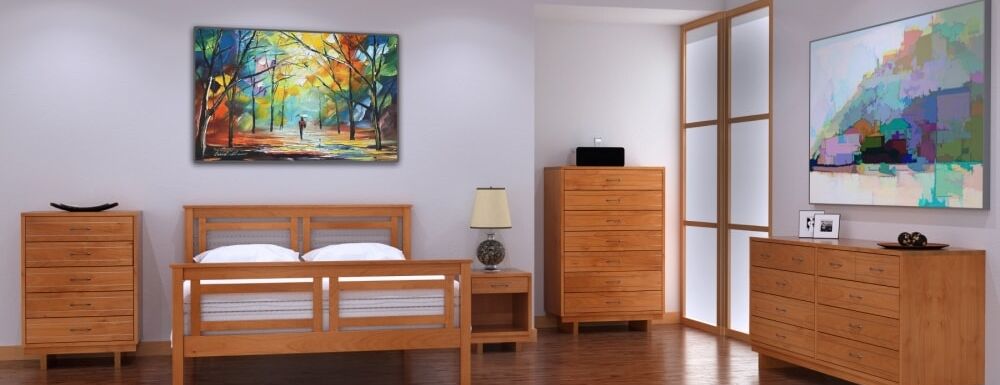
FAQ
What is in this furniture?
A good deal of furniture today is built using veneers (on plywood, or even on particle board). There is some very high quality furniture made using veneers, but they are normally decorative, not structural, pieces. In addition, low quality veneer work, or veneers on low quality substrate, often look very different than solid wood. We use plywood ONLY in the drawer bottoms and case backs, where they are unseen and are actually the best product for the job. On request, these can be replaced with solid hardwood as well. Our end panels are solid hardwood inserted in solid hardwood frames, which provide depth and interest to the sides of the furniture.
How is the hardwood selected?
We use only the highest quality hardwood, selected for us for color and width, so we can match the boards that are used in the construction of a single item. Our drawer fronts are single pieces, and they are cut from a single board across the full width of our dressers. In our cherry furniture, you will not see sap (white) wood anywhere on the outside of our furniture. This requires a great deal of time and effort, as we pore through the wood piles selecting the perfect pieces for each part of our furniture. Many manufacturers have the lumber coming down to the workers on conveyor belts, limiting the time they have for selection and matching. We give each employee all the time that they need to get these choices right. Examine the furniture you are considering to see if the wood was selected carefully and if glued pieces have matching color and grain.
How is the furniture built?
There are three ways to assemble furniture: the first is to screw it together, which is the poorest form of construction. The screws will inevitably lose their grip in the wood and there is little or no way of repairing it. Furniture built this way is not heirloom quality. The second is to create mortise and tenon glue joints, but to clamp the furniture only briefly while screwing the joints together. Then the furniture is removed from the clamps and the screws hold it together while the glue is drying. This is clearly superior to the screw-only method, but it does not create truly tight and rigid joints, as the screws won’t hold the joints firmly while the glue is drying. The third way – the way high quality furniture has been built for centuries, is to glue the tenons into the mortises and clamp the joints overnight. This creates strong, rigid joints that will keep the furniture solid for generations. In addition, should severe shock break a joint, it can easily be re-glued and clamped again for a perfect repair.
The things to do to find out how a piece of furniture is assembled are: 1) ask the salesperson to show you literature from the manufacturer- it will usually tell the truth about assembly, although in some cases they may not mention it; 2) try to rock the furniture – cases built using the first and second methods will often rock – the dresser will have internal movement, and it will be kept square only by using the plywood back as a stiffener; 3) look for signs of screws: what looks like visible dowels are often plugs hiding screws.
Needless to say, our furniture is clamped overnight - our cases are overbuilt and extremely rigid, and will stay that way for generations.
What kind of finish is used on the furniture?
There are many decent finishes used on hardwood furniture and they all serve a particular purpose. We use an oil and wax finish because it brings out the depth of color and the beauty of the grain of the wood. It is also environmentally sound- it is applied by hand, with no spraying and no chemicals released into the air. It has the disadvantage of requiring some care, but it is also easily repairable if damaged. While you can repair an oil finish at home, a lacquer finish must be completely stripped off and re-sprayed. Bedroom furniture needs very little care; it is only dining tables and heavy-use items that need regular waxing.
How do the parts fit?
Our final assembly crew is given the right to spend as much time on each piece as it takes to get every drawer and door perfectly centered in its space and operating smoothly. No shortcuts are taken, and every piece that leaves our shop is ready to be used in your home. That is not true of all manufacturers, so you must look carefully at the fit and finish of the floor samples you see, and hope that the product delivered to you is well-built.